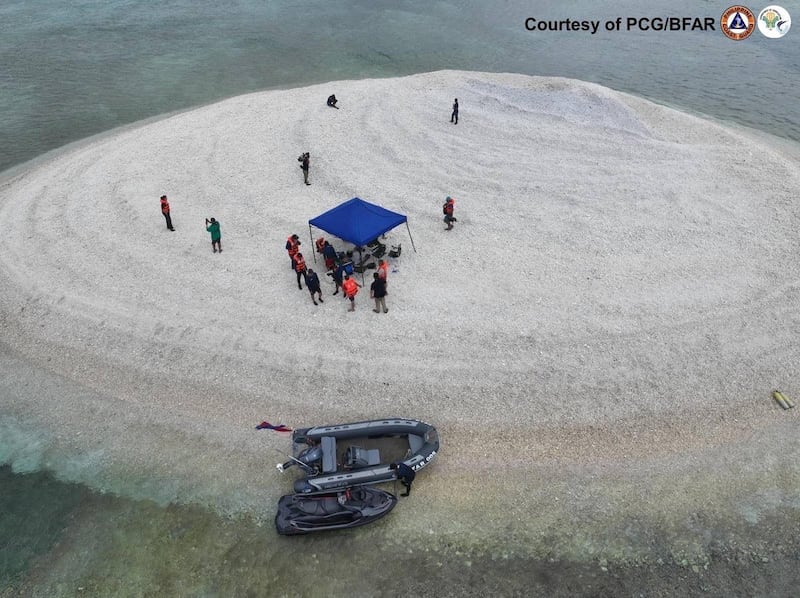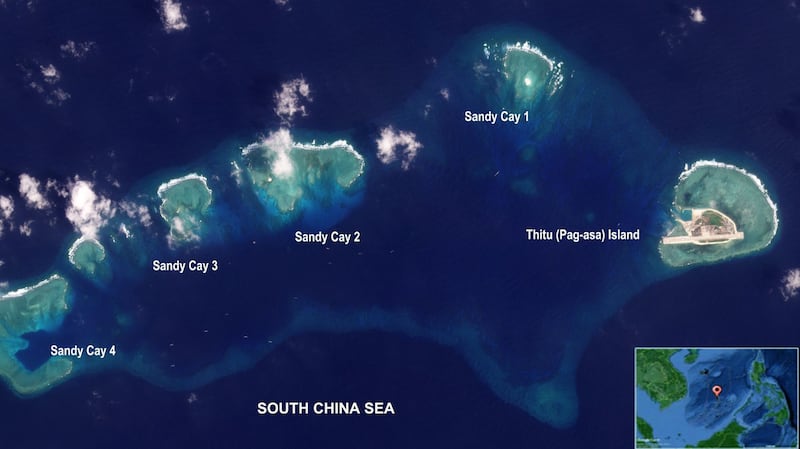China has protested against a marine research expedition launched by Filipino scientists in Sandy Cay, a group of rocks seen as strategically important for both countries within the Spratly islands in the South China Sea.
The event could potentially reignite one of the most contentious issues over sovereignty between Beijing and Manila in recent years.
"34 individuals from the Philippines ignored China's warning and illegally landed on Tiexian Reef on Thursday," Chinese coast guard spokesperson Gan Yu said in a statement.
Tiexan Reef is the Chinese name for Sandy Cay, a group of cays – or low reefs – situated just 2 nautical miles (3 kilometers) from Philippines-occupied Thitu island, known as Pag-asa island in Tagalog.
Chinese law enforcement officers “investigated and handled the case in accordance with the law,” Gan Yu said without giving further details.
“The Philippines’ actions infringe on China’s territorial sovereignty, violate the Declaration on the Conduct of Parties in the South China Sea, and undermine peace and stability in the South China Sea,” Gan said. “We urge the Philippines to immediately stop the infringement.”
The Chinese coast guard “will continue to carry out rights protection and law enforcement activities” in the area, the spokesman added.
Ray Powell, director of the SeaLight project at U.S. Stanford University, told Radio Free Asia that as of Friday morning, as many as 15 Chinese vessels including the 100-meter China Coast Guard (CCG) 5204 were seen crowding the area between Sandy Cay and Thitu island.
Marine research
The Philippines on Thursday said three groups of its scientists launched a marine research to study underwater reef biodiversity in the area and its current status.
The lead scientist, Jonathan Anticamara, was quoted in local media as telling a press conference that this is the first time such research is being conducted in all four parts of Sandy Cay.
“The research will have different components such as for environmental assessment, biochemical assessment, basic water parameters, and fish visual census, among others,” Anticamara was quoted as saying.
Initial findings on Sandy Cay 1 and 2 would be presented as soon as Friday.

Philippine coast guard spokesperson Jay Tarriela told the same press conference that it was the government who invited the scientists to carry out the research and authorities have dispatched four law enforcement vessels to accompany them in case Chinese vessels block them from Sandy Cay.
“Simple observations and measurements of their current status, which do not affect their natural state, do not affect the dispute overall since scientific activities are not a legal basis for either asserting or contesting sovereign claims,” said Jay Batongbacal, director of the University of the Philippines Institute for Maritime Affairs and Law of the Sea.
However, Beijing views the scientific expedition differently.
The think tank South China Sea Probing Initiative called it a "provocation" and questioned whether there was a connection between the research and the visit to Manila by U.S. Secretary of State Antony Blinken on March 19.
China has repeatedly accused Washington of interfering in the South China Sea dispute and criticized the U.S.’s assistance to the Philippines.
Sovereignty rights
Sandy Cay is contested by China, the Philippines, Vietnam and Taiwan.
Under the U.N. Convention on the Law of the Sea (UNCLOS), Sandy Cay is a rock that is permanently above water and therefore is entitled to a territorial sea of 12 nautical miles from its banks.
Whichever country controls Sandy Cay would have legal sovereignty rights over any other feature located within its territorial sea, such as Subi Reef - a Chinese artificial island that Beijing has fully militarized with missiles and an airstrip.

Legal experts say if China gains sovereignty over Sandy Cay, it would validate both its claim and occupation of Subi Reef, just 10 nautical miles away.
But Sandy Cay also lies within the territorial sea of Philippines-controlled Thitu island, the largest island of a municipality in the province of Palawan.
With both China and the Philippines vying to assert sovereignty over the area, the situation could become precarious.
Filipino fishermen accused Chinese coast guard and maritime militia vessels of maintaining a constant presence in the area, blocking their access to Sandy Cay.
“It is not Philippine activities which complicate the situation, but rather China’s overreaction and increasing need to establish absolute control over everything in the South China Sea to pursue to excessive and illegitimate claims,” Batongbacal from the Institute for Maritime Affairs and Law of the Sea told RFA.
In 2016, a landmark arbitral tribunal brought by the Philippines ruled against all China’s claims in the South China Sea but Beijing has rejected the verdict, calling it “illegal, null and void.”
Edited by Mike Firn and Taejun Kang.

